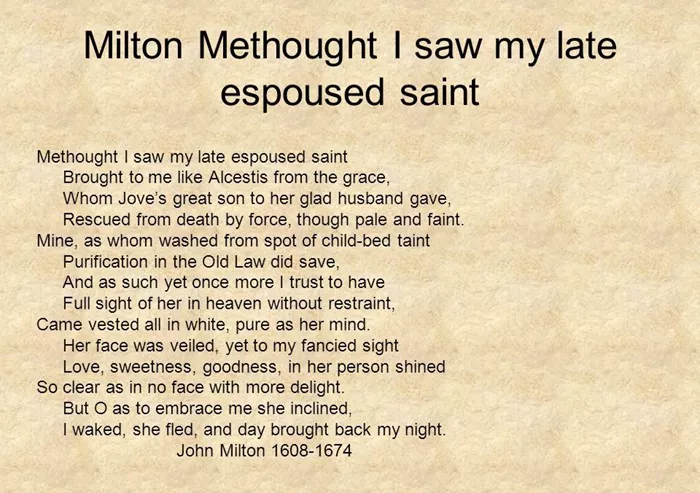Welcome to Poem of the Day – Methought I Saw My Late Espoused Saint by John Milton
John Milton, one of the most revered poets of the English Renaissance, is widely known for his epic masterpiece Paradise Lost. However, Milton also wrote many shorter poems that explore personal grief, love, and loss. One such poem is Methought I Saw My Late Espoused Saint, a deeply emotional and reflective work that explores Milton’s sorrow after the death of his second wife, Katherine Woodcock, who died in 1658. This poem is not only a personal lament, but also a profound meditation on love, loss, and the possibility of reunion in the afterlife.
Methought I Saw My Late Espoused Saint Poem
Methought I saw my late espoused saint
Brought to me, like Alcestis, from the grave,
Whom Jove’s great son to her glad husband gave,
Rescu’d from death by force, though pale and faint.
Mine, as whom wash’d from spot of child-bed taint
Purification in the old Law did save,
And such as yet once more I trust to have
Full sight of her in Heaven without restraint,
Came vested all in white, pure as her mind;
Her face was veil’d, yet to my fancied sight
Love, sweetness, goodness, in her person shin’d
So clear as in no face with more delight.
But Oh! as to embrace me she inclin’d,
I wak’d, she fled, and day brought back my night.
Methought I Saw My Late Espoused Saint Explanation
Overview of the Poem
The title of the poem, Methought I Saw My Late Espoused Saint, translates to “I thought I saw my recently departed wife.” The speaker in the poem is Milton himself, reflecting on a dream-like vision of his late wife. The poem is written in the first person, which creates a direct connection between the poet and his emotions. It is often described as a “dream vision,” where the speaker experiences an encounter with the loved one who has passed away.
Poem’s Structure and Style
The poem consists of two stanzas, each of which develops the speaker’s emotional journey. The first stanza begins with the speaker’s dream of seeing his wife once again. The second stanza describes the profound sadness that the vision causes, for though the speaker is momentarily reunited with his wife, he is reminded that she is gone from this world forever.
Milton uses vivid and powerful imagery throughout the poem. For example, he describes his wife as a “saint” who is now “in heaven.” This not only elevates her memory but also underscores the religious and spiritual dimensions of his grief. The use of religious imagery is significant, as Milton often blends his personal experiences with his religious beliefs.
Explanation of the Poem
The poem begins with the speaker describing his vision in which he believes he sees his late wife, whom he calls his “espoused saint.” The term “espoused” refers to his wife, while “saint” emphasizes her purity and the holiness of their marriage. Milton writes that the vision felt so real that it almost seemed as though she had returned to him. However, as the vision unfolds, the speaker is reminded that his wife is no longer alive, and he is faced with the painful reality of her death.
In the second stanza, the speaker expresses his longing for his wife’s return, even as he acknowledges that their reunion is impossible in the physical world. He describes his deep sorrow and the emotional toll of losing her, but there is a sense of acceptance that she is now at peace in heaven.
The final lines of the poem reflect a yearning for the hope of reunion in the afterlife. The speaker imagines that they will be together again when he reaches heaven, and this thought provides a sense of comfort, even though it cannot erase the pain of his loss.
Themes and Analysis
Love and Loss: At its core, this poem explores the profound impact of losing a loved one. Milton’s deep affection for his wife is evident in how he describes her in such idealized terms. The speaker’s longing for his late wife shows the depth of their emotional connection.
The Afterlife and Spiritual Beliefs: The vision of the wife as a “saint” in heaven speaks to Milton’s belief in the afterlife. The idea that love can transcend death is central to the poem’s message. Though the speaker is left grieving, the possibility of reuniting in heaven offers hope.
Grief and Healing: The poem can be seen as a therapeutic exercise in expressing grief. Milton channels his sorrow into a poetic vision, giving voice to his emotional pain. In doing so, he creates a work that is not only personal but universally relatable to anyone who has experienced loss.
Conclusion
Methought I Saw My Late Espoused Saint by John Milton is a poignant and moving poem that reflects the poet’s personal grief over the death of his wife. Through vivid imagery and spiritual themes, Milton explores the complex emotions of love, loss, and the hope of a reunion after death. The poem resonates with readers who have experienced similar feelings of sorrow and longing, making it a timeless work of emotional depth. Milton’s ability to blend personal reflection with universal themes is what continues to make his poetry so enduring and powerful today.

